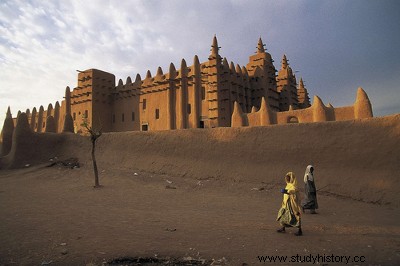
By Me. Cláudio Fernandes
In general, the study of the period Medieval focuses on three main axes:the formation of Christianity in Western Europe, the development of the Byzantine Empire in Eastern Europe, and the birth and expansion of Islamic civilization, from the Iberian Peninsula to Persia, also covering North and South Africa. from Europe. Normally, when it comes to the issue of Islamic expansion, the question of the civilizations that developed in Africa is touched upon. during this period, but in a very succinct and not very expressive way. Africa on Age Average constitutes a topic that must be studied in a punctual and systematic way, given that it interests everyone who wants to understand in depth the formation of the modern world.
Since Ancient Age, on the African continent, some civilizations have stood out enormously. It was the case of the Carthaginians (of Phoenician origin), who settled in northwest Africa; of civilization Egyptian, which flourished in northeast Africa from the Nile River Delta; of the Nubian civilization, situated below Egypt; from the kingdom of Axum, that developed in the region of present-day Ethiopia, among others. All of these civilizations, some to a greater and lesser extent, maintained contact with the civilizations of Western Europe, such as the Roman, and others that developed in the Arabian Peninsula, the Iranian plains and the Far East.
This entire region of North Africa began to suffer, in the Middle Ages, an intense penetration of civilization Arabic Islamized. From the 7th century onwards, Islam began to expand throughout the Arabian Peninsula and towards North Africa and southern Europe. In this period, there was at the same time a clash and a cultural enrichment with the local African cultures, as well as with the civilizations of that continent that had already been Christianized.
In the Maghreb region , conversion to Islam took place systematically, from powerful kingdoms like that of Mali even nomadic peoples. With Islamization, the practice of slavery, which was very common on the African continent since antiquity, intensified. As the historian Ricardo da Costa, a specialist in the Middle Ages, emphasized:“By converting half of Africa, Islam contributed a lot to encourage slavery even more, as it practiced it from an early age:even before Mohammed, in the 6th century, Arab merchants frequented every port on the east coast of Africa, trading grain, meat and dried fish with Bantu tribes for slaves. The non-Muslim black populations also considered slavery an absolutely normal fact (as we will see, normally African kings had hundreds of slaves as soldiers – and in their personal guards!)”. [1]
In addition to the kingdom of Mali, other kingdoms were also prominent on the African continent in this period, especially those that developed below the Sahara desert, such as Ghana, Kanem-Bornu, Yoruba and Benin. The main form of contact and trade between these kingdoms was the caravans from camels , which allowed them to travel long distances in the middle of the desert with a very large amount of food, precious stones, slaves, metals, porcelain, carpets and many other things.
NOTES:
[1] :COSTA, Ricardo da. Arab expansion in Africa and the Black Empires of Ghana, Mali and Songhay. In :NISHIKAWA, Taise Ferreira da Conceição. Medieval History:History II .
São Paulo:Pearson Prentice Hall, 2009, p. 34-53.
